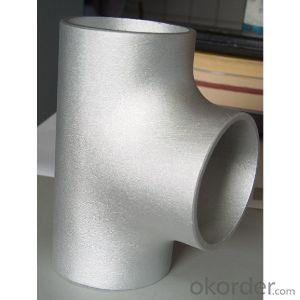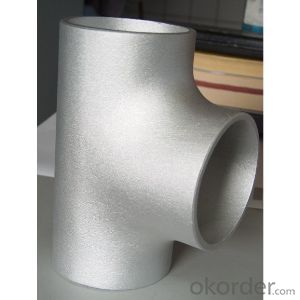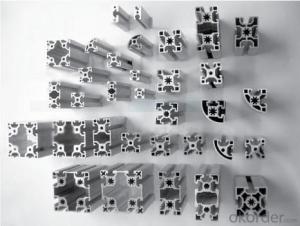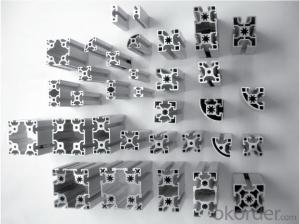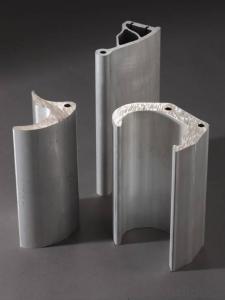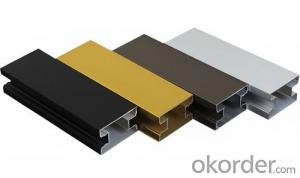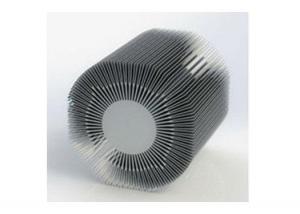20x40mm Aluminum Tee Profile Used on Construction
- Loading Port:
- Shanghai
- Payment Terms:
- TT OR LC
- Min Order Qty:
- 5 m.t.
- Supply Capability:
- 1000 m.t./month
OKorder Service Pledge
OKorder Financial Service
You Might Also Like
Specifications
aluminum tube tee
Material:Aluminum
Size:1/2'' to 72''
Thickness:sch10-XXS
Certificate:API,ISO9001,PED
Product Description
Type | aluminum pipe fittings --tee |
OD | 1/2"-48" |
WT | SCH40-SCH160 |
Standard | ASME, GB, DIN, JIS ,BS, ISO, and so on. |
Material | 7075,7050,7055,2024,1100,6262,6082,5052,3003 and so on |
Certificate | ISO9001:2000 , ASME and Boiler A-level |
Packaging | wooden case or pallet |
Application | petroleum, chemical industry, medicine, electric power, astronautics, war industry, fire prevention, metallurgy, shipbuilding, fuel gas, nuclear electricity, urban construction, hot-water heat and environmental protection etc. |
Others | Special design available according to your request |
- Q: What is the thickness of the aluminum alloy window frame?
- The national standard "Aluminum Alloy window" has been specified, aluminum wall thickness not less than 1.2 mm. In other words, the main wall thickness of ordinary aluminum alloy window structure should not be less than 1.2 mm, the main wall thickness of the door structure profiles should not be less than 2 mm.
- Q: Are aluminum profiles suitable for use in exterior insulation systems?
- <p>Yes, aluminum profiles can be used for exterior insulation systems. They offer high strength, durability, and resistance to weathering, making them ideal for external applications. Aluminum profiles are lightweight, easy to install, and can be used to create a robust framework for insulating materials, enhancing the energy efficiency and thermal performance of buildings.</p>
- Q: Are aluminum profiles suitable for use as interior finishing materials, specifically for flooring and wall panels?
- <p>Yes, aluminum profiles can be used for interior finishing materials such as flooring and wall panels. They are known for their durability, low maintenance, and resistance to corrosion. Aluminum profiles are lightweight, easy to install, and can be used in various designs and styles, making them a popular choice for modern interior design. They also offer the advantage of being recyclable and environmentally friendly.</p>
- Q: Are aluminum profiles suitable for awnings and canopies?
- Yes, aluminum profiles are suitable for awnings and canopies. Aluminum is a lightweight and durable material that can withstand various weather conditions. It is resistant to corrosion, making it ideal for outdoor applications. Additionally, aluminum profiles can be easily customized and are available in different designs, making them a popular choice for awnings and canopies.
- Q: Changhe brand aluminum can?
- Profile is not bad, but visibility is not too large, the whole is still very good, cost-effective
- Q: What are the minimum thickness specifications for aluminum alloy door and window profiles?
- The main force member without the minimum wall thickness of aluminum profile measured door surface treatment not less than 2, the window is not less than 1.4, piecing material, horizontal and vertical should be determined through calculation, please refer to the specific GB8478:2008 Aluminum Alloy "window"
- Q: What are the potential environmental effects linked to the utilization of aluminum profiles?
- <p>Yes, there are environmental impacts associated with using aluminum profiles. The production process consumes significant energy, contributing to greenhouse gas emissions. Aluminum production also generates waste, including red mud, which can be harmful if not properly managed. However, aluminum is recyclable, and recycling reduces energy consumption and waste generation. The environmental impact can be mitigated by using recycled aluminum and adopting sustainable production practices.</p>
- Q: Can aluminum profiles be used in the production of transportation containers?
- Indeed, the utilization of aluminum profiles is possible for the manufacturing of transportation containers. Aluminum, being a lightweight and long-lasting material, is widely employed in various industries, including transportation. It presents several advantages for container production, encompassing resistance to corrosion, a high strength-to-weight ratio, and effortless fabrication. By employing aluminum profiles, one can construct the framework and walls of transportation containers, which ensures structural integrity while maintaining a low overall weight. Moreover, aluminum profiles can be conveniently customized and shaped to meet specific container requirements. All in all, the incorporation of aluminum profiles in the production of transportation containers offers numerous benefits and is a favored choice among manufacturers.
- Q: Can aluminum profiles be custom-designed or customized?
- Yes, aluminum profiles can be custom-designed or customized according to specific requirements. Aluminum is a highly versatile material that can be easily shaped and manipulated into different forms. Customizing aluminum profiles allows for the creation of unique shapes, sizes, and finishes to meet the specific needs of various applications. Custom design and customization of aluminum profiles can involve altering dimensions, creating intricate shapes, adding slots or holes for assembly, incorporating specific features or accessories, and even applying various surface treatments or coatings. This flexibility in design and customization enables aluminum profiles to be used in a wide range of industries and applications, such as construction, automotive, aerospace, electronics, and more. The process of customizing aluminum profiles typically involves collaboration between the manufacturer and the customer. The manufacturer will work closely with the customer to understand their requirements, provide technical support, and offer design solutions that meet their specific needs. This may include creating prototypes, conducting tests, and making adjustments until the desired custom design is achieved. Overall, aluminum profiles can indeed be custom-designed or customized to suit specific requirements, making them a preferred choice for many industries seeking unique and tailored solutions.
- Q: The company must tender, but it needs material certification, but what do not know exactly?
- Enterprise legal person business license, China Quality Association approved, the national industrial product production permit, 9001 certificate, a copy of tax registration certificate. Surely that will be enough
Send your message to us
20x40mm Aluminum Tee Profile Used on Construction
- Loading Port:
- Shanghai
- Payment Terms:
- TT OR LC
- Min Order Qty:
- 5 m.t.
- Supply Capability:
- 1000 m.t./month
OKorder Service Pledge
OKorder Financial Service
Similar products
Hot products
Hot Searches
Related keywords
